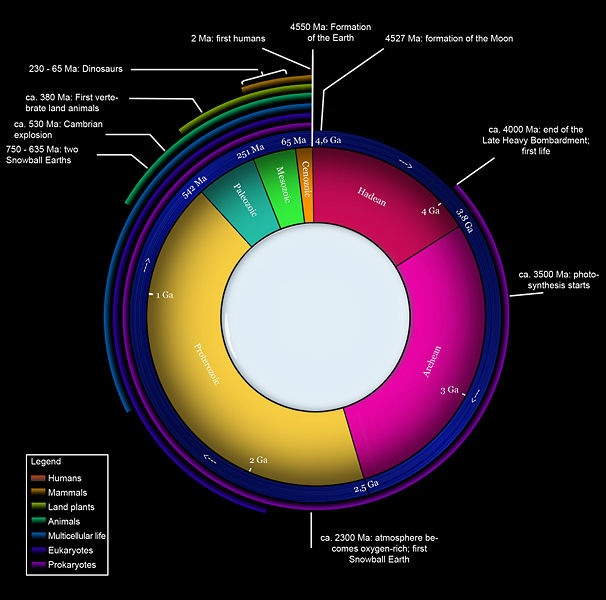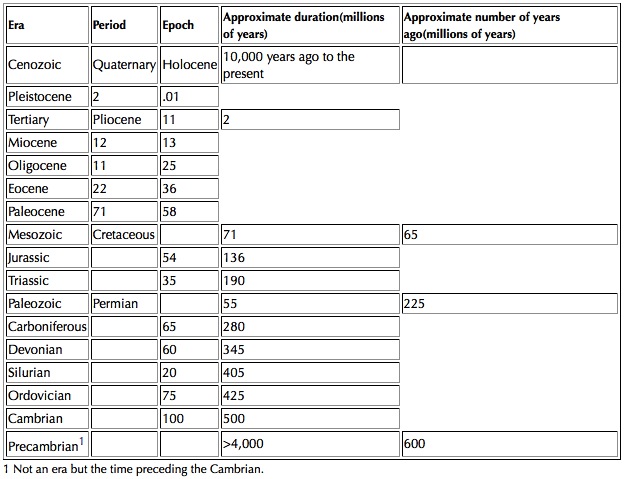Difference between revisions of "Geologic Timescale"
m (Text replacement - "http://nordan.daynal.org" to "https://nordan.daynal.org") |
|||
| Line 2: | Line 2: | ||
[[File:Geologic_clock.jpg|center|frame]] | [[File:Geologic_clock.jpg|center|frame]] | ||
| − | The '''geologic time scale''' provides a [[system]] of chronologic [[measure]]ment relating [http://en.wikipedia.org/wiki/Stratigraphy stratigraphy] to [[time]] that is used by geologists, paleontologists and other [[Earth Science|earth scientists]] to describe the [[timing]] and [[relationships]] between [[events]] that have occurred during the [ | + | The '''geologic time scale''' provides a [[system]] of chronologic [[measure]]ment relating [http://en.wikipedia.org/wiki/Stratigraphy stratigraphy] to [[time]] that is used by geologists, paleontologists and other [[Earth Science|earth scientists]] to describe the [[timing]] and [[relationships]] between [[events]] that have occurred during the [https://nordan.daynal.org/wiki/index.php?title=The_Urantia_Text_-_Contents#Part_III._The_History_of_Urantia history of the Earth][http://en.wikipedia.org/wiki/History_of_the_Earth]. The table of geologic time spans presented here agrees with the dates and [[Names|nomenclature]] proposed by the [http://en.wikipedia.org/wiki/International_Commission_on_Stratigraphy International Commission on Stratigraphy], and uses the [[standard]] [[color]] codes of the [http://en.wikipedia.org/wiki/United_States_Geological_Survey United States Geological Survey]. |
[[Evidence]] from [http://en.wikipedia.org/wiki/Radiometric_dating radiometric dating] indicates that the [[Earth]] is about 4.570 billion years old. The geological or deep time of Earth's past has been organized into various units according to [[events]] which took place in each period. Different spans of time on the time scale are usually delimited by major geological or paleontological events, such as [[Catastrophism|mass extinctions]]. For example, the boundary between the Cretaceous period and the Paleogene period is defined by the [http://en.wikipedia.org/wiki/Cretaceous%E2%80%93Tertiary_extinction_event Cretaceous–Tertiary extinction event], which marked the demise of the [http://en.wikipedia.org/wiki/Dinosaur dinosaurs] and of many marine species. Older periods which predate the reliable fossil record are defined by absolute age. | [[Evidence]] from [http://en.wikipedia.org/wiki/Radiometric_dating radiometric dating] indicates that the [[Earth]] is about 4.570 billion years old. The geological or deep time of Earth's past has been organized into various units according to [[events]] which took place in each period. Different spans of time on the time scale are usually delimited by major geological or paleontological events, such as [[Catastrophism|mass extinctions]]. For example, the boundary between the Cretaceous period and the Paleogene period is defined by the [http://en.wikipedia.org/wiki/Cretaceous%E2%80%93Tertiary_extinction_event Cretaceous–Tertiary extinction event], which marked the demise of the [http://en.wikipedia.org/wiki/Dinosaur dinosaurs] and of many marine species. Older periods which predate the reliable fossil record are defined by absolute age. | ||
Revision as of 22:27, 12 December 2020
The geologic time scale provides a system of chronologic measurement relating stratigraphy to time that is used by geologists, paleontologists and other earth scientists to describe the timing and relationships between events that have occurred during the history of the Earth[1]. The table of geologic time spans presented here agrees with the dates and nomenclature proposed by the International Commission on Stratigraphy, and uses the standard color codes of the United States Geological Survey.
Evidence from radiometric dating indicates that the Earth is about 4.570 billion years old. The geological or deep time of Earth's past has been organized into various units according to events which took place in each period. Different spans of time on the time scale are usually delimited by major geological or paleontological events, such as mass extinctions. For example, the boundary between the Cretaceous period and the Paleogene period is defined by the Cretaceous–Tertiary extinction event, which marked the demise of the dinosaurs and of many marine species. Older periods which predate the reliable fossil record are defined by absolute age.

